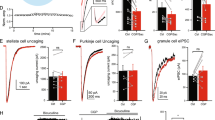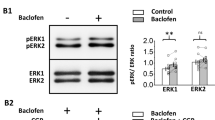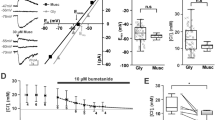Abstract
Baclofen has been used as an antispastic agent for over a decade1, yet its mechanism of action is still not fully understood. While early iontophoretic studies revealed a depression of neuronal activity2–4, more recent studies have emphasized a presynaptic depression of transmitter release, both in the peripheral5,6 and central nervous sytem7–14, possibly resulting from a blockade of calcium channels15. Although baclofen is structurally similar to the inhibitory neurotransmitter, γ-aminobutyric acid (GABA), none of its actions seem to be antagonized by the GABA antagonist, bicuculline. However, recent experiments have indicated that baclofen binds to a class of bicuculline-resistant GABA receptors, termed GABAB receptors16. Here, we have analysed the action of baclofen on the membrane potential of CA1 hippocampal pyramidal cells in vitro and report that it directly hyperpolarizes these cells in a potent, stereoselective manner which is resistant to bicuculline methiodide. This response is associated with a decrease in neuronal input resistance and may involve an increase in potassium conductance.
This is a preview of subscription content, access via your institution
Access options
Subscribe to this journal
Receive 51 print issues and online access
$199.00 per year
only $3.90 per issue
Buy this article
- Purchase on Springer Link
- Instant access to full article PDF
Prices may be subject to local taxes which are calculated during checkout
Similar content being viewed by others
References
Birkmayer, W. Spasticity—a Topical Survey (Huber, Vienna, 1972).
Curtis, D. R., Game, C. J. A., Johnston, G. A. R. & McCulloch, R. M. Brain Res. 70, 493–499 (1974).
Davies, J. & Watkins, J. C. Brain Res. 70, 501–505 (1974).
Olpe, H. R. et al. Eur. J. Pharmac. 52, 133–136 (1978).
Bowery, N. G. et al. Eur. J. Pharmac. 71, 53–70 (1981).
Kleinrok, A. & Kilbinger, H. Naunyn-Schmiedebergs Archs. Pharmak. 322, 216–220 (1983).
Pierau, F. K. & Zimmermann, P. Brain Res. 54, 376–380 (1973).
Davidoff, R. A. & Sears, E. Neurology 24, 957–963 (1974).
Fox, S., Krnjevic, K., Morris, M. E., Puil, E. & Werman, R. Neuroscience 3, 495–515 (1978).
Potashner, S. J. J. Neurochem. 32, 103–109 (1979).
Bowery, N. G. et al. Nature 283, 92–94 (1980).
Ault, B. & Evans, R. H. Eur. J. Pharmac. 71, 357–364 (1981).
Collins, G. S., Anson, J. & Kelly, E. P. Brain Res. 238, 371–383 (1982).
Shapovalov, A. I. & Shiriaev, B. E. Gen. Physiol. Biophys. 1, 423–433 (1982).
Dunlap, K. Br. J. Pharmac. 74, 579–585 (1981).
Bowery, N. G., Hill, D. R. & Hudson, A. L. Br. J. Pharmac. 78, 191–206 (1983).
Nicoll, R. A. & Alger, B. E. J. Neurosci, Meth. 4, 153–156 (1981).
Lanthorn, T. H. & Cotman, C. W. Brain Res. 225, 171–178 (1981).
Ault, B. & Nadler, J. V. J. Pharmac. exp. Ther. 223, 291–297 (1982).
Kandel, E. R., Spencer, W. A. & Brinley, F. J. J. Neurophysiol. 24, 225–242 (1961).
Andersen, P., Eccles, J. C. & Løyning, Y. J. Neurophysiol. 27, 592–607 (1964).
Eccles, J. C., Nicoll, R. A., Oshima, T. & Rubia, F. J. Proc. R. Soc. 198, 345–361 (1977).
Ben-Ari, Y., Krnjevic, K., Reiffenstein, R. J. & Reinhardt, W. Neuroscience 6, 2445–2463 (1981).
Alger, B. E. & Nicoll, R. A. Science 210, 1122–1124 (1980).
Hotson, J. & Prince, D. A. J. Neurophysiol. 43, 409–419 (1980).
Schwartzkroin, P. A. & Stafstrom, C. E. Science 210, 1125–1127 (1980).
Nicoll, R. A. & Alger, B. E. Science 212, 957–959 (1981).
Thalmann, R. H. & Ayala, G. Y. Neurosci. Lett. 29, 243–248 (1982).
Thalmann, R. H. Neurosci. Abstr. 8, 797 (1981).
Lancaster, B. & Wheal, H. V. J. Physiol., Lond. 334, 118P (1983).
Newberry, N. R. & Nicoll, R. A. J. Physiol., Lond. 348, 239–254 (1984).
Blaxter, T. J. & Cottrell, G. A. J Physiol., Lond. 330, 46P (1982).
Author information
Authors and Affiliations
Rights and permissions
About this article
Cite this article
Newberry, N., Nicoll, R. Direct hyperpolarizing action of baclofen on hippocampal pyramidal cells. Nature 308, 450–452 (1984). https://doi.org/10.1038/308450a0
Received:
Accepted:
Issue Date:
DOI: https://doi.org/10.1038/308450a0
This article is cited by
-
GABA tone regulation and its cognitive functions in the brain
Nature Reviews Neuroscience (2023)
-
Direct neurotransmitter activation of voltage-gated potassium channels
Nature Communications (2018)
-
GABAB receptor activation mediates frequency-dependent plasticity of developing GABAergic synapses
Nature Neuroscience (2008)
-
GABAB receptors and synaptic modulation
Cell and Tissue Research (2006)
-
Effect of latent iron deficiency on GABA and glutamate neuroreceptors in rat brain
Indian Journal of Clinical Biochemistry (2003)
Comments
By submitting a comment you agree to abide by our Terms and Community Guidelines. If you find something abusive or that does not comply with our terms or guidelines please flag it as inappropriate.



